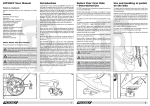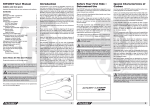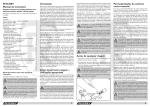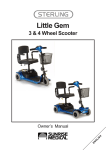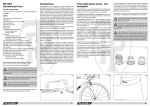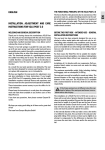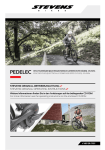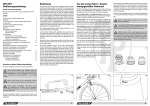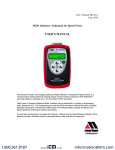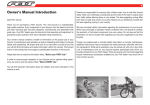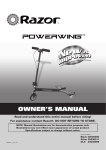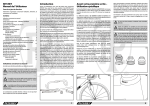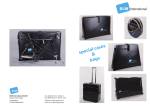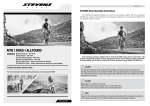Download RITCHEY User Manual Introduction Before Your First Ride
Transcript
RITCHEY User Manual Introduction Forks and Headsets Important information about use, care, maintenance and installation Contents Notes on This User Manual Introduction Before Your First Ride – Determined Use Before Every Ride Special Characteristics of Carbon Cleaning and Care Maintenance General Notes on Installation RITCHEY Liquid Torque RITCHEY Torqkey Headset Checking the Headset Adjusting the Aheadset®-Headset Headset Maintenance What to Bear in Mind with Carbon Steerer Forks What to Bear in Mind with Integrated and Semi-Integrated Headsets Installing the Bearing Cup Races of Conventional and Semi-Integrated Aheadsets® into the Frame Installing Forks with Threadless Carbon Steerer Installing Aheadset®-Stems Mounting the Front Wheel How to Use the Quick-Releases Warranty Terms A Note on Wear Manufacturer´s Guarantee 1 1 2 3 3 4 4 5 5 6 7 7 8 9 10 10 10 11 12 13 14 15 15 16 Congratulations, when buying a RITCHEY part, you made a superb choice. RITCHEY develops, tests and manufactures our products with dedication to uphold the highest standards of quality. Like all high-quality sports equipment, RITCHEY components require careful installation in order to function properly and to provide long-term dependability. We recommend that you ask a qualified mechanic at your authorized RITCHEY dealer for help with installation and use RITCHEY parts (a) together whenever possible in order to achieve optimum performance and durability. Our precise tolerances are intended to ensure component compatibility, and are carefully monitored during production and quality control so that installation will be easy and trouble-free. This manual contains important notes about use, care, maintenance and installation. Please read this manual carefully, beginning with the general information, followed by the chapter referring to the component you purchased, or you intend to use. Doing so will ensure smooth installation and trouble-free use of the product. Keep this user manual for your records and future reference. If you sell or lend your component or bike to someone, share this manual with the new user. With RITCHEY components, as with all lightweight bicycle products, special care and attention need to be paid to proper installation and intended use. Materials used by RITCHEY are extremely strong and durable, with very low weight. However, sometimes they can break, rather than bend, in the event of an accident. Internal damage to the component may not show up obviously or with visible signs of damage. In the event of undue stress of any kind, e.g. as a result of a crash, the components need to be inspected by a qualified mechanic to ensure the product is safe to use. Therefore, consult your RITCHEY dealer after any such occurrence. Before Your First Ride – Determined Use RITCHEY forks (b) and headsets (c+d) are designed for road racing, triathlon (i.e. time trial), cyclocross or mountain bikes and their typical use. Road racing, triathlon and time trial bicycles are exclusively designed for cycling on tarred and hard-surface tracks with a smooth surface. Cyclocross bicycles are designed for off-road cycling over typical cyclocross terrain, e.g. on field tracks and forest trails; they are, however, not suitable for all-mountain and enduro use, downhill (DH) riding, freeriding, dual slalom, downhill/freeride parks, jumps, drops etc. Mountain bikes are designed to be used for off-road cycling and for riding over natural terrain (e.g. terrain of a mountain bike marathon and cross-country racing). Due to their design and equipment they are, however, not intended to be used on public roads. If you intend to use this type of bicycle on public roads, it must be fitted with the devices and equipment prescribed for this purpose. Standard cross-country, marathon and all-mountain bikes are not suitable for freeriding, dual slalom, downhill riding, jumps or the like. There are special mountain bike types for these specific forms of cycling. We recommend that you always use RITCHEY parts together in order to achieve optimum performance and component durability. If you intend to combine RITCHEY parts with parts from other manufacturers, make sure they are compatible, i.e. that all dimensions are identical with the specifications given in this manual. Forks and headsets are designed for an overall load of 110 kilos (242 lbs) including rider and baggage, e.g. rucksack. In case of any inquiries, please contact your RITCHEY dealer. After a crash, accident or other major impact, have your RITCHEY forks, headsets, etc. checked by your RITCHEY dealer for your own safety. If your fork or headset produces any “creaking” or “cracking” noises or shows any external damage, such as notches, cracks, dents, discolorations, etc., do not use your bike anymore until you have consulted your local RITCHEY dealer, who will check the part carefully and replace it, if necessary. For more information see the specifications in our catalogue and/ or visit us at www.ritcheylogic.com. Do not ever make any changes to forks and headsets. Do not file or drill holes in RITCHEY components, especially in carbon parts, as it will compromise their structural integrity and void your warranty. (c) RITCHEY forks are designed to be only used with threadless headsets, also referred to as Aheadset®-headset! Attempting to use a RITCHEY fork in combination with quill-stems can lead to sudden failure, resulting in a crash with unforeseeable consequences. Notes on This User Manual Pay particular attention to the following symbols: This symbol means that your life or health may be in danger unless you comply with provided instructions or carry out prescribed measures. This symbol warns you about actions that could lead to damage of property or the environment. (a) (b) (d) This symbol indicates there is special information on how to handle the product and may refer you to a specific passage in this manual requiring your special attention. L The possible consequences described above are not repeated every time one of the symbols appears! 1 2 Before Every Ride Check the following points before setting off: Special Characteristics of Carbon 1. Are the quick-release levers or nuts of the front and rear wheel properly closed (a)? For more information, see sections “How to Use the Quick-Releases“ and “Mounting the Front Wheel”. All RITCHEY products made of carbon fiber-reinforced resin, also referred to as carbon (c) or abbreviated CFR, require special care and attention. Improperly closed quick-releases can cause the wheels to come loose. This can lead to a serious accident! 2. Check whether the headset is free of play and moves easily (b). Make a visual inspection! 3. Verify the tight fit of the stem on the fork steerer. L Read the manual of your bicycle manufacturer before you set off! Carbon (d) is an extremely strong material which combines high compression resistance with low weight. Please note that carbon, unlike metals, shows no visible deformation after undue stress even though some of its fibers may be damaged. This makes it very dangerous to continue using a carbon part after an impact or undue stress, as it may fail without previous warning, thereby causing an accident with unforeseeable consequences. If your RITCHEY carbon part sustained this kind of impact or undue stress, we strongly recommend that you take your complete bike to your RITCHEY dealer for inspection. They will check the damaged bike and, if necessary, replace the deficient part. In case there are any unanswered questions or doubts, the dealer can contact the RITCHEY after-sales department or one of the RITCHEY distributors directly. For safety reasons RITCHEY components made of carbon must never be repaired; they must be replaced at once. Prevent further use by taking appropriate measures, i.e. destroy the damaged component. (a) Cleaning and Care Maintenance Clean your fork (e) and the headset (f) with water and a soft rag at regular intervals. If necessary, use a non abrasive soap to remove grime. You may add a little detergent liquid for cleaning and removing tough stains, such as oil or grease, from hard surfaces. Do not use degreasing agents, which contain organic solvents (e.g. acetone, trichloroethylene, methylene, etc.). Chemicals of this sort may damage the finish or substructure of the material. Check the tightening torque of all bolts after the first 200 to 400 km (120 to 240 miles) or 10 to 20 hours of use. Tighten them, if necessary, with a torque wrench to the prescribed torque setting. Thereafter, check every 2,000 km (1,200 miles) or 100 hours of use! After your bike has dried, apply a wax based polish to painted, carbon and metal surfaces (exception: braking surfaces). Polish the parts after the wax has dried. With this treatment your fork and the headset will keep their nice appearance for years. While cleaning, look for cracks, scratches, dents, as well as for bent or discoloured material. If you think there may be a problem, see your local RITCHEY dealer. Have damaged or defective components replaced immediately. Loose or overly tightened bolts may result in an accident! Although headsets have seals, they are not entirely tight. Therefore, have the headset dismounted and re-lubricated by an authorized RITCHEY dealer at least once a year, depending on the intensity of use. Make absolutely sure to keep the braking surfaces or rotors free of cleaning agent, grease or oil. Otherwise the braking performance might be drastically reduced or even rendered ineffective. Be sure to never store the fork and the headset in the blazing sun or near a source of heat. Parts made of carbon must under no circumstances be exposed to excessive heat. Therefore, never have a carbon component enamelled or powder-coated. The temperatures required for doing so could destroy it. Do not leave carbon fiber parts near a source of heat or in a car or trunk during hot or sunny weather. (e) If any notches, tears, deformations, dents or discolorations etc. are visible on your carbon part, or if it makes “creaking” or “cracking” noises, do not use the bike until the part has been replaced! After undue stress, a crash or other major impact, replace the part or have it inspected by your local RITCHEY dealer before using it again. open close (b) (c) 3 (d) (f) 4 General Notes on Installation In general, fork, headset, stem and handlebar installation are jobs for skilled mechanics. We therefore recommend that you have these jobs performed by an authorized RITCHEY dealer. Each of the following instructions must be followed strictly. Non-observance of these instructions can lead to component failure, resulting in a severe accident or injuries. Installing non-matching parts can result in clamping failure and consequently in a serious accident. We recommend using RITCHEY forks, headsets, stems and handlebars together (a), as they are designed to fit and function as an integrated whole. If you choose to use a part from another manufacturer, read the respective manual regarding size accuracy to ensure proper fit and compatibility with RITCHEY components. RITCHEY assumes no responsibility for problems resulting from a RITCHEY component being used with a part from another manufacturer. RITCHEY strongly advises against using stems with a large recess in the steerer clamp pointing towards the stem. The top and bottom collar of the steerer clamp must measure 5 mm at least. Stems with recesses on the rear side of the steerer clamp are unsuitable! Before installation watch out for sharp edges and burrs on all clamping surfaces of the fork, the headset, the stem (b) and the handlebars. Do not use these components, if they have burrs or sharp edges. If there are burrs or sharp edges on a RITCHEY or nonRITCHEY component, have your local RITCHEY dealer inspect it to see, whether it is usable or whether the issue can be remedied and how. If you fit a headset to an existing fork, check the steerer tube and the old headset carefully for scratches, abrasion marks and notches after removing them. Notches in the contact area indicate defective processing or deficient design of the headset in these areas. Do not use parts, if you are not absolutely sure about their compatibility. In case of any doubt, ask your RITCHEY dealer who will contact, if necessary, our after-sales service hotline. Do not use damaged parts! If you have the slightest doubt, we recommend that you replace the part. Do not use your bike until this has been done. RITCHEY Liquid Torque Installing components with RITCHEY Liquid Torque Carbon fiber components are particularly vulnerable to damage caused by excessive clamping force. RITCHEY Liquid Torque (c) creates extra friction between two surfaces, allowing the tightening torque to be reduced by up to 30%. This is especially useful in the clamping areas of fork, stem and handlebars, i.e. areas where too much clamping force can damage either component, causing component failure or voiding the warranty. By reducing the clamping force, RITCHEY Liquid Torque relieves stress on sensitive carbon surfaces, preventing damage to fibers or the cracking of the carbon substructure. It also retains its effectiveness in wet conditions and provides maximum protection against corrosion. Precautions for use RITCHEY Torqkey Prior to applying RITCHEY Liquid Torque, remove dirt particles and lubricant residues from the surfaces to be treated. Next, apply a thin and even film of RITCHEY Liquid Torque to the cleaned surfaces using a brush, lint-free rag or chamois/artificial chamois. Install components as directed by the manufacturer, by using a torque wrench (such as the RITCHEY Torqkey recommended for use with all RITCHEY forks, handlebars and stems) and take care not to exceed the manufacturer’s maximum torque recommendations. After tightening to specified tightening torque, wipe off any excess Liquid Torque. To achieve long lasting and problem-free clamping of parts, RITCHEY considers the use of a torque wrench absolutely necessary. The RITCHEY Torqkey (d) is designed for use with all RITCHEY stems. It is a 4 mm hex bolt/Allen wrench pre-set to 5 Nm, which is both the ideal clamp force as well as the maximum prescribed torque, used to tighten RITCHEY stem bolts. If 5 Nm of torque does not generate sufficient clamping force, apply RITCHEY Liquid Torque to interconnecting surfaces to increase friction. Re-seal RITCHEY Liquid Torque container after use. Additional information Many manufacturer warranties will not cover damage to component due to over-tightening. Refer to manufacturer’s recommended torque limits for each component. Always use a torque wrench to verify you are within specified torque limits, and do not exceed them. Using RITCHEY Liquid Torque will allow you to safely install your bicycle components – particularly in the case of carbon fiber – without exceeding the torque limits specified by the manufacturers. In most cases, using Liquid Torque will enable you to use as much as 30% less torque while installing your components. RITCHEY Liquid Torque is neutral to copper and aluminium alloys, steel and synthetic material, and will not damage product surfaces. Exceeding 5Nm of torque on clamp bolts of stem or handlebars creates too much clamping force, which can lead to component failure. This not only bears a high risk of accident, but also voids the warranty. Loose or overly tight bolts can result in component failure and in an accident. Strictly observe the torque specifications. If you do not have a high-quality torque wrench or a RITCHEY Torqkey, see your local RITCHEY dealer. For bolts tightened to another tightening torque than 4 Nm, please use the RITCHEY Torque Wrench (tightening torque from 2 to 16 Nm)! For detailed information about both tools, visit the online shop of RITCHEY International at www.ritchey.ch. RITCHEY Liquid Torque can be used for all carbon, aluminium and steel connections including: • Stem/steerer tube clamping areas • Seat post/frame clamping areas • Stem/handlebars clamping areas and clamping bolts (a) (b) 5 (c) (d) 6 Headset Checking the Headset The headset connects the fork to the frame, but allows it to move freely. It must turn with virtually no resistance, if the bicycle is to run straight, stabilising itself as it travels. Shocks caused by uneven road surfaces expose the headset to considerable levels of stress. As a result of this it can become loose and go out of correct adjustment. You should check the headset at regular intervals, readjust it, if necessary, and have it greased at least once a year. Noises, in particular cracking noises, are often due to a lack of lubrication. If you have a fork with steel/aluminium steerer tube, you can apply mounting grease on the steerer tube in the area of the headset and the spacers, however, not in the area of the stem clamping. Furthermore, you can apply mounting grease between all headset components and spacers. This does NOT apply to full-carbon forks. The surface between steerer tube and stem as well as between the pre-load mechanism (clamping cone) and the inner side of the steerer tube must remain free of grease, otherwise a reliable clamping of these components cannot be granted. If you have a carbon fork, the grease must, therefore, be applied carefully and systematically between the steel/aluminium parts of the bearing, the clamping or between the contact areas of the aluminium spacers. Recurring bearing play may be due to insufficient friction between stem and fork and/or to a poor fit of the counter bearing in form of a cone mechanism in the fork steerer. Apply a thin layer of RITCHEY Liquid Torque on the clamping surfaces to ensure a proper and gentle clamping. Adjusting the Aheadset®-Headset Pull the front wheel brake and place the fingers of your other hand around the gap between frame and upper bearing cover (b). Bring your weight to bear on the saddle and push the bicycle a little back and forth. If there is movement at the gap, the headset shows too much play. Repeat this test with the front wheel turned crossways. Letting the front wheel bounce to the ground from a height of approx. 10 cm is another method that requires, however, a certain amount of experience. Knocking noises indicate too much bearing play. However, rattling brake levers, cables or cycle computers may be misguiding! To check whether the headset turns smoothly, take hold of the top tube and lift the front part of the bicycle until the front wheel is about 20 cm above the ground. With a little tap on the grips, the handlebars should turn easily until either the brake touches the frame or the handlebars hit the top tube. Perfom this test to the right and to the left. If the handlebars do not turn or only half way, slacken the cables and try again. In case there is any cracking or rubbing noise, check where it comes from. Often these noises are due to cables that are dry or even rusty in their cable stops. In this case, please apply thin lubricant. If that still does not help, check whether the fork turns freely at the bottom of the head tube and whether the bearing cover has enough play. The gaps as well as the seals must be even. To check the headset turn the fork from far left to far right. Furthermore, check whether the fork steerer ends 2 to 3 mm beneath the top edge of the stem (a), otherwise adjusting the bearing play is impossible. Adjusting the headset is a job for a skilled mechanic. Have this work done by an authorized RITCHEY dealer. If you intend to do the adjustment on your own, please note that you need special tools, e.g a RITCHEY Torqkey. Check the tight clamping once again. If the stem is still not tight, fork and stem are probably incompatible. Replace the stem by a matching model or ask your RITCHEY dealer for assistance. L Release the clamping bolts on the stem side by two to three turns without unscrewing them entirely. The Allen bolt located in the top cap is intended to re-adjust the bearing play (c). Turning the bolt clockwise removes play, as the stem is pressed downward on the bearing; turning the bolt anticlockwise increases the play. Check the headset as described in chapter “Checking the Headset”. In case there is bearing play, tighten the adjusting bolt by another quarter or half a turn. With carbon steerer tubes, make sure the inside of the tube is supported by an expander-cone mechanism (for adjusting the headset). Check the tight clamping of the stem by holding the front wheel between your knees and trying to turn the handlebars relative to the front wheel. A loose stem can lead to an accident! If the stem cannot be tightened on the fork steerer tube with a tightening torque of 5 Nm, in spite of RITCHEY Liquid Torque on the clamping surfaces, stem and fork are incompatible. Replace the stem by a matching model or ask your RITCHEY dealer for assistance. Do not overtighten the top Allen bolt, it is intended for adjustment! Tighten the bolt carefully in quarter-turns and check the play regularly. Once the play is properly adjusted, bring the stem in alignment with the front wheel. Check the alignment from the top (d). The handlebars should be at right angle to the direction of motion. Tighten both clamping bolts alternately by using the RITCHEY Torqkey. If you use a standard torque wrench, start with a minimum tightening torque of 4 Nm (e). In case the stem clamping is not tight enough, increase the tightening torque to 5 Nm or until the RITCHEY Torqkey clicks. (d) After adjusting the headset check the tight clamping of the stem by holding the front wheel between your knees and trying to turn the handlebars relative to the front wheel. In case the stem is not tight, do not tighten the bolts any further, but use RITCHEY Liquid Torque instead in order to increase friction in the clamping areas. Steering resistance or play in some handlebar positions can be due to improper fit, i.e. when the bearing races in the frame are not snug as a result of deficient processing or when unsuitable bearings were mounted. In such an event, please contact your RITCHEY dealer. Headsets come in different diameters and angles. Often the exact headset description is printed directly on the cartridge bearing. If not, a headset gauge that you can obtain from your RITCHEY dealer will help you. L (a) (b) (c) (e) 2FP mm 7 8 Headset Maintenance The maintenance of the headset, the removal of noises in spite of correct adjustment or an insufficient steering behaviour require a dismounting of the fork from the frame. The maintenance of the headset is a job for a skilled mechanic. Have this work done by an authorized RITCHEY dealer. If you want to try it on your own, you should have the know-how and experience of a mechanic as well as special tools, if necessary. Apply plenty of grease (not RITCHEY Liquid Torque) on the bearing and bearing races during reassembly that will seal the bearings in addition (c). Wipe off excess grease after reassembly. The top clamping area of carbon steerer tubes must remain free of grease. Undo the front brake and remove the front wheel. Unscrew the top Allen bolt completely and remove the top cap. Release the bolt(s) on the stem side. Pull off the handlebars including stem, keep hold of the fork with one hand and let the handlebars/stem hang down. Make sure frame, levers, handelbars and stem remain undamaged. Remove the spacers (a), the bearing cover and the upper bearing cone. Clean the parts with a rag and arrange them in the order you removed them. Keep the order in mind. Carefully pull out the fork and wipe off any dirt from the parts (b). Check on the dismounted fork, whether the crown race was installed horizontally, whether it is in sound condition (i.e. without notches), and whether the steering tube is free of scratches, notches, colour changes etc. over its entire length and circumference. Remove the bearings, wipe off the grease from the bearing cup races. Check whether the bearings turn freely and without play and make sure they are free from chips etc. If you have an open bearing headset, you should check in addition, whether they are well greased. Make sure there are no chafe marks or notches. Asymmetrical marks of that kind indicate a careless processing. Observe the correct order of assembly and place the lower bearing on the crown race. The bevel of the cartridge bearing’s outer ring, normally, shows in direction of the head tube, whereas the bevel of the cartridge bearing’s inner ring shows to the crown race. Slide the fork from below into the head tube of the frame. Slide the upper bearing that is greased on the outside, the upper bearing cone, the bearing cover and the spacers completely on the steerer tube until the fork is mounted almost free of play. Make sure the clamping area of the stem is absolutely free of grease and apply Liquid Torque. Slide the stem on the steerer tube and plug in the top cap. Adjust the headset as above described. (b) What to Bear in Mind with Carbon Steerer Forks Carbon steerer tubes must remain free of grease, otherwise a reliable and sufficient clamping of the stem will not be achieved. You would require high tightening torques damaging the steerer tube or the stem and resulting in a failure. Degrease the stem and the fork with benzine or spirit, if necessary. Apply RITCHEY Liquid Torque subsequently (d)! Pre-load mechanisms acting as counter bearing for the adjusting bolt inside the fork steerer are often delivered without being greased. In this case increased inner friction prevents the transformation of bolt force into clamping force. Apply grease specifically on the inner, bevelled surfaces of the slotted sleeve and the inner cone. The outer surface of the sleeve must remain free of grease. Apply RITCHEY Liquid Torque in this area, as well, bevor tightening the mechanism in the fork steerer (e). Never use a star nut as counter bearing inside the fork steerer! Risk of breakage! What to Bear in Mind with Integrated and Semi-Integrated Headsets With integrated headsets the upper and lower bearing cup races are part of the head tube, with semi-integrated headsets they are normally pressed in by the manufacturers. This allows smooth transitions between headset, fork and stem. The crown race is normally provided with a slit that allows an easy installation on the fork steerer. rosion! Apply grease on the entire headset including bearing cup races to ensure smooth running and to prevent cor- Verify that the gaps between bearing cover and head tube as well as between fork crown and lower bearing cup race are evenly parallel. If they are not, the bearings possibly run rough. (a) (c) 9 (d) Installing the Bearing Cup Races of Conventional Aheadset®Headsets and Semi-Integrated Aheadset®-Headsets into the Frame The installation of the Aheadset®-headset is a job for a skilled mechanic. Have this work done by an authorized RITCHEY dealer. If you want to try it on your own, you should have the know-how and experience of a mechanic as well as special tools, if necessary. Place the crown race horizontally onto the fork crown. Slide the crown race onto the steerer either manually or with an appropriate special tool. With the desired, minor undersize of the crown race towards the fork crown you need to tap slightly on the crown race to bring it into the correct position without leaving any gap between crown race and fork crown. Keep the fork in hand during tapping and do not put it down – risk of breakage! Before installation thoroughly check the cleaned fork steerer, in particular the fork crown and the stem clamping area, for damage, such as cracks. Perform the installation only with headset tools. An appropriate press fit of the bearing cup races into the frame can only be achieved with these tools. Precondition is, however, that the tolerances are observed and that the surfaces gliding on top of one another are well greased. Verify not to slide on the bearing cup races in oblique position and make sure they are flush. Tighten the special tool evenly and observe as the bearing cup races slide into the head tube. Bearing cup races that you can slide in manually will cause cracking or rattling noises during cycling. Degrease the bearing cup races and the inner face of the headset in a metal frame and apply some two-component adhesive, according to the manufacturer’s instructions. If you have a carbon frame apply RITCHEY Liquid Torque! Let the adhesive harden before re-installing the fork. (e) 10 Installing Forks with Threadless Carbon Steerer If there is hardly any resistance when sliding on the crown race due to an improper fit, apply some two-component epoxy adhesive to fix it additionally. The cutting of the steerer tube, the press fitting of the crown race and the installation of the fork into the frame are jobs for a mechanic. Have this work done by an authorized RITCHEY dealer. An unauthorized installation and maintenance will render the warranty void. Assemble all parts of the headset, insert the desired number of spacers under the stem and mark the top edge of the stem. Improper installation increases the risk of breakage for the fork and the stem. Risk of an accident! Each of the following instructions must be followed strictly. Non-observance of these instructions can result in a fork failure and lead to a crash with serious consequences. Measure the crown race and the fork crown first. Forks with 1“-steerer tubes (steerer tube diameter 25.4 mm) require bearing races at a nominal diameter of 26.4 mm (with partly large tolerances). Forks with 1 1/8”- steerer tubes (steerer tube diameter 28.6 mm) require crown races at a nominal diameter of 30.0 mm. Verify that the fork crown is circular and that the diameter is not 0.1 or 0.2 mm bigger than the inner diameter of the crown race. With 1“-forks the fork crown should not be smaller than 26.4 mm and with 1 1/8“-forks not smaller than 30.0 mm, otherwise a tight press fit of the precise crown race cannot be ensured. Do not apply grease or oil on the steerer tube in the clamping area of the stem, as this will prevent a reliable clamping! If you have not yet found your preferred position of the stem, insert more spacers under the stem to begin with. Observe the maximum stacking height of spacers of 30 mm under the stem. Do not clamp the fork into a vice to cut it, as this could damage the fork steerer. Clamp the fork steerer into a suitable device instead, e.g. into a special bracket. Use a sharp, fine-toothed metal saw (24 teeth) and cut the fork steerer at low pressure 2 mm below your marking. Make sure to keep the inner steerer tube free of chips and dust. Use a file to gently remove any burrs from the area of the cut (a). Insert the file from the outside to the inside and not vice versa, otherwise the fibres will fray out. Do not blow off the saw chips. Remove the chips with a damp rag and dispose of them together with the rag! Verify that the contact area of fork crown and crown race is clean and apply a little grease (except one of the clamping surfaces is made of carbon!). Hit the crown race with an appropriate special tool until it is in horizontal position and until any gap between crown race and fork crown has disappeared. Keep the fork in hand during hitting and do not put it down – risk of breakage! (a) Seal the cut with two-component adhesive (epoxy resin), clear varnish or super glue. Wipe off excess adhesive from the steerer tube side immediately upon sealing. Make sure all spacers and the clamping area of the sleeve are free of burrs. RITCHEY carbon steerer tubes are manufactured with fine tolerances. For this reason the stems normally fit snugly on the fork steerer tube. Do not install stems that have play on the fork steerer. L Use RITCHEY Liquid Torque to ensure a reliable fit and low tightening torques! If you have strictly followed the above instructions, you will not need high tightening torques for the clamping bolts. The recommended tightening torque is 4 - 5 Nm depending on the stem type. With a standard torque wrench start from the minimum value and approach the maximum value by proceeding in small 0.5 Nm (4.45 inlbs) increments. With a RITCHEY Torqkey turn until it clicks. Check the tight fit of the stem and the fork by trying to turn the handlebar relative to the front wheel (b). Do not exceed the tightening torque prescribed by the stem manufacturer and a maximum tightening torque of 5 Nm for the fork. Check the tightening torque of all bolts after 200 to 400 km (120 to 240 miles) or 10 to 20 hours of use and then every 2,000 km (1,240 miles) or 100 hours of use. Install the brake callipers to the fork. If there is no extra long nut delivered with the road racing fork, use the sleeve nut of the brake manufacturer for brake installation. Verify that the nut has a minimum grip of 8 turns! The stem clamping area must be free of burrs and the fork steerer must have enough support inside the stem. Stems with many recesses in the clamping area or with a cut-out in the clamping area pointing towards the stem are not suitable. The top and bottom collar should measure 5 mm at least. The steerer tube clamp must be closed, i.e. it must be free of any recesses. No matter what type of brake you install (V-brake, disc brake or else), be sure to read the manual of the brake manufacturer beforehand. Follow the installation instructions and pay special attention to the tightening torques. (b) (c) L Installing Aheadset®-Stems Many RITCHEY stems can be installed in either vertical orientation. These “flip-flop” models allow handlebars to be positioned at two different heights by simply inverting the stem (c). Verify that the stem and fork steerer tube always have matching or compatible clamp diameters (d)! If you intend to install a 1 1/8“-stem on a 1”-fork steerer, use a reduction sleeve at the suitable length. Make sure the slots of stem and sleeve are accurately on top of one another. If you fit a new stem on a fork with carbon steerer tube, check the clamping area for notches or abrasion marks. In case such damage is actually visible, ask your RITCHEY dealer whether it is necessary to have the fork replaced. Make sure the clamping areas are absolutely free of grease, especially when the clamping surfaces are made of carbon. Apply RITCHEY Liquid Torque in the clamping areas. Use RITCHEY Liquid Torque to optimize clamp hold. Grease the threads and the connecting surfaces/heads of the steerer clamp bolts. Keep lubricants away from clamping surfaces. Slide the stem onto the fork steerer tube. It must fit snugly onto the fork. Do not fit stems which have play on the steerer tube. Depending on the steerer tube length and the desired stem position, install spacers on the fork steerer above the upper cover of the headset, and/or above the stem. You can stack them up to a maximum height of 30 mm. These spacers are available in different heights. You have installed the correct number of spacers, when the steerer tube ends 2 mm below the top edge of the stem. The brake rotor diameter approved by RITCHEY is 180 mm. Larger rotors can lead to a fork failure and thus cause an accident! (d) UHVHW 00 6(7 PPL QFK 11 2RQ 12 Verify that the stem provides sufficient support for the steerer tube and that the steerer tube ends 2 mm at the most below the top edge of the stem (a). This ensures a reliably clamping when tightening the clamping bolts of the steerer tube clamp to the the prescribed tightening torque. If your preferred stem height results in a deeper position of the stem on the steerer tube, the steerer tube projects from the stem. To check the correct position, insert spacers (b) at an appropriate height on top of the steerer tube. After the test ride the steerer tube of a carbon fork must be shortened. The space between the top of the steerer tube and the upper edge of the stem should not exceed 2 mm. Tighten the stem bolts only a little, if you intend to install the handlebar right afterwards. Finish by adjusting the headset. The clamp bolts of RITCHEY stems are designed to oppose each other for proper load distribution during clamping. Please check that the bolt heads of RITCHEY stems are always oriented in opposition to each other. L (a) Mounting the Front Wheel Once you have installed the headset and the fork, you need to remount the front wheel. L Be sure to also read the manual of your bicycle manufacturer before mounting or removing the wheels. After you have mounted the wheel, make sure it is correctly seated in the drop-outs and accurately centred between the fork legs. Check the correct seat of the quick-release and • close the release lever of the rim brake (Shimano, SRAM) immediately or shift the bolt in the gear/brake lever at the handlebar back to its original position (Campagnolo), • if you have V-rim brakes (V-brakes) and cantilever brakes, make sure you hook the brake cable back immediately! Verify that the brake pads touch the rim and not the tire or the spokes. • Re-mount the hydraulic rim brakes and close its quick-release immediately after fixing the wheel! Verify that the brake pads touch the rim and not the tire or the spokes. • If you have disc brakes, check before mounting the wheel whether the brake pads rest snugly in their seats in the brake calliper body. The gaps between the brake pads and the wheel should be parallel and the wear indicators in their correct position. Make sure you guide the rotor between the brake pads carefully. • After mounting the wheel and tightening the quick-release pull the brake lever (c) (in the case of disc brakes several times) and spin the wheel. The rotor should not drag on the brake caliper or on the brake pads. Make sure the brake pads touch the rim and not the tire or the spokes. Always test the brakes in stationary after mounting a wheel. By pulling the lever you should get a positive braking response. The brake lever must, however, remain clear of the handlebars. If it does not, check the bicycle and the brake system according to your general bicycle manual. Before riding on your bicycle check that after the installation the brake surfaces, the rotors and the brake pads are still free of grease or other lubricants. No matter what type of brake you install (V-brake, disc brake or else), be sure to read the manual of the brake manufacturer beforehand. Follow the installation instructions and pay special attention to the tightening torques. How to Use the Quick-Releases As the use of quick-releases is not always common knowledge, they have been the cause of accidents. We recommend that you read the following instructions thoroughly and practice the handling as outlined. Ask your RITCHEY dealer for advice. The wheels are attached to the frame at the hub axles. Each axle is clamped tight in its drop-outs by means of a quick-release. Quick-release retention mechanisms essentially consist of two operative parts (d): 1. The quick-release lever on one side of the wheel: Release this lever to loosen the wheel and close it to create a strong clamping force on a 180 degree axis. 2. The tightening nut on the other side of the hub with which the initial tension on the threaded rod is set. To remove the wheel open the quick-release lever (e) and loosen the tightening nut by a few turns, if necessary. The front wheel is usually additionally secured by means of drop-out catches at the fork tips which prevent the wheel from coming off, in the event of an unintentional loosening of the quick-release. (d) The clamping force should be adjusted in a way that by closing the quick-release you feel significant resistance over the second half of its travel (f). The quick-release is accurately tight, when a clockwise turning in closed condition is impossible by applying pressure to the front. 2FP mm (b) (c) 13 (e) (f) 14 Warranty Terms A Note on Wear Manufacturer’s Guarantee Under European consumer law, the purchaser has full statutory warranty rights within the first two years from date of purchase. In North America, these rights apply to the first year from the date of purchase. According to these laws, your dealer is responsible for ensuring the product is free of defects that could cause premature wear from normal use. Bicycle components are subject to wear due to normal and proper use. The rate of wear will depend on care and maintenance, the bicycle usage and the environmental conditions, such as rain, mud, dust, and sand. Some components require regular care and maintenance. Nevertheless, despite the best maintenance program, all components will eventually reach the end of their service life depending on intensity and conditions of use. RITCHEY products have been developed and manufactured with great care and have gone through numerous testing controls. Our products are examined as part of our internal quality control process to meet strict standards as well as by external, independent test laboratories. The two year warranty law is only valid in countries where European (EU) regulations apply! Please ask your RITCHEY dealer about the regulations in your country. The following RITCHEY components are especially subject to wear due to the nature of their intended use and not covered for wear under this warranty: L Warranty claims will only be accepted, if the bicycle has been used solely for its intended purpose (see section, “Before Your First Ride – Determined Use”). • The lubricants and seals of the bearings For the EU market we grant, independent of legal regulation, a voluntary guarantee that your RITCHEY product is free of manufacturing and processing defects for two years from the date of purchase. For the North American Market we grant, independent of legal regulation, a voluntary guarantee, that your RITCHEY product is free of manufacturing and processing defects for one year from date of purchase (except from lubricants and seals). It does not cover damage resulting from wear (lubricants, seals), neglect (insufficient care and maintenance, bearing play), accidents, overstress caused by overloading, incorrect installation, improper treatment or as a result of changes to the components. RITCHEY Design Inc. Sales & Warranty Office 575 Old County Road San Carlos, CA 94070 In case of any inquiries, please contact your national distributor. Find contact information for your national distributor at www.ritcheylogic.com. The manufacturer’s guarantee only applies to claims made by the initial buyer, who must present the purchase receipt with date of purchase, dealer address and model number. Guarantee claims will only be accepted, if the bicycle has been used in accordance with the intended use of RITCHEY products. This guarantee does not cover damage resulting from: • • • • • • In the event of a defect or if you have a warranty issue, please contact the RITCHEY dealer who sold you the bicycle component in question. RITCHEY has exclusive agreements with all RITCHEY dealers to handle potential warranty claims. If you purchase a RITCHEY product from an unauthorized RITCHEY dealer, e.g. from an internet auction site, the warranty granted by RITCHEY becomes void, so you must seek resolution with the reseller who sold you the product. European Authorized Representative Obelis s.a Bd. Général Wahis 53 1030 Brussels, BELGIUM Your direct contact for any issue is your RITCHEY dealer/reseller, who is authorized to respond to your inquiries. In the event you have not purchased the product from an RITCHEY dealer, RITCHEY can possibly not guarantee the expected quality for the product. Your direct contact with regard to all issues outlined in this manual and corresponding instructions is your local RITCHEY dealer, who is qualified to answer your questions. To handle your claim you need to present your receipt. RITCHEY Corporate HQ’s 620 Spice Island Drive Sparks, NV 89431 The guarantee does not cover labour and transport costs, nor does it cover follow-up costs resulting from defects. L Be sure to strictly follow all assembly instructions in this manual as well as all additional instructions provided by the manufacturers of products used in conjunction with RITCHEY products, especially bolt torque specifications and the prescribed maintenance instructions. Observe all instructions with regard to procedures and verification processes listed in this manual as well as any other instructions that may be included in the delivery of RITCHEY products. Also adhere strictly to any and all instructions referring to the replacement of safety-relevant components, e.g. in the case of colour changes of the components. RITCHEY International Via Cantonale 2 CH- 6916 Grancia-Lugano In the event of a warranty claim, RITCHEY reserves the right to provide all or part of the current successor model in an available colour – or if such part is not available, a higher grade model – to remedy the claim. The guarantee does not cover assembly, refitting costs or any new accessories that may be required (e.g. different dimension parts). wear neglect (insufficient care and maintenance) accidents overstress caused by overloading incorrect installation or improper treatment changes or modifications to the component (e.g.: improper fork cutting) The instructions of this and all other RITCHEY manuals are drawn up carefully to maximize the service life of RITCHEY products. Any guarantees are void, if installation instructions are ignored and/or if regular inspection and maintenance intervals are neglected. RITCHEY Design Inc. Taiwan Branch 22-1, #123 Chungang Rd. Sec 3 Taichung 407 Taiwan R.O.C. If you have any question, please ask your national distributor .You will find a distributors list at www.ritcheylogic.com. 15 Technical details in the text and illustrations of this manual are subject to change. © No part of this publication may be reprinted, copied or transmitted by hand or with mechanical or electronic systems or used for an another business purpose without prior written permission. Concept and text: Zedler – Institut für Fahrradtechnik und -Sicherheit GmbH www.zedler.de Edition 2, January 2013 16









